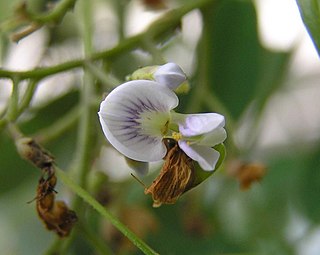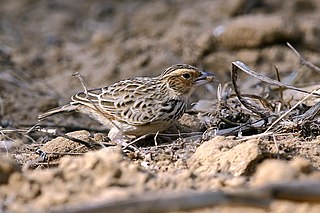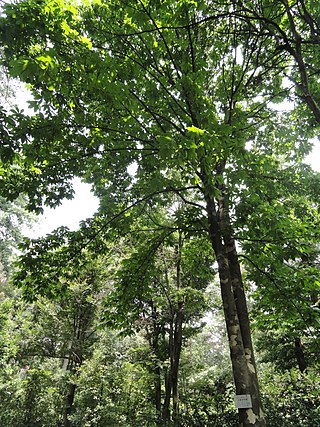
The International Union for Conservation of Nature (IUCN) Red List of Threatened Species, also known as the IUCN Red List or Red Data Book, founded in 1964, is an inventory of the global conservation status and extinction risk of biological species. A series of Regional Red Lists, which assess the risk of extinction to species within a political management unit, are also produced by countries and organizations.

The honey locust, also known as the thorny locust or thorny honeylocust, is a deciduous tree in the family Fabaceae, native to central North America where it is mostly found in the moist soil of river valleys. Honey locust trees are highly adaptable to different environments, and the species has been introduced worldwide. Outside its natural range it can be an aggressive, damaging invasive species.

Garcinia is a genus of flowering plants in the family Clusiaceae native to Asia, America, Australia, tropical and southern Africa, and Polynesia. The number of species is disputed; Plants of the World Online (POWO) recognise up to 400. Commonly, the plants in this genus are called saptrees, mangosteens, or garcinias, and is one of several plants known as by the name "monkey fruit".

Gleditsia is a genus of trees in the family Fabaceae, subfamily Caesalpinioideae, native to the Americas and Asia. The Latin name commemorates Johann Gottlieb Gleditsch, director of the Berlin Botanical Garden, who died in 1786.

The Bengal bush lark or Bengal lark is a species of lark in the family Alaudidae found in southern Asia.

Camellia sinensis is a species of evergreen shrub or small tree in the flowering plant family Theaceae. Its leaves, leaf buds, and stems can be used to produce tea. Common names include tea plant, tea shrub, and tea tree.

The conservation status of a group of organisms indicates whether the group still exists and how likely the group is to become extinct in the near future. Many factors are taken into account when assessing conservation status: not simply the number of individuals remaining, but the overall increase or decrease in the population over time, breeding success rates, and known threats. Various systems of conservation status are in use at international, multi-country, national and local levels, as well as for consumer use such as sustainable seafood advisory lists and certification. The two international systems are by the International Union for Conservation of Nature (IUCN) and The Convention on International Trade in Endangered Species of Wild Fauna and Flora (CITES).

Jerdon's bush lark or Jerdon's lark is a species of lark in the family Alaudidae found in south Asia. This was formerly considered as a subspecies of Mirafra assamica and termed as the Madras bushlark. Two other species in the complex include Mirafra marionae and Mirafra microptera. Jerdon's bush lark is typically very pale on the underside

A species that is extinct in the wild (EW) is one that has been categorized by the International Union for Conservation of Nature as only consisting of living members kept in captivity or as a naturalized population outside its historic range. Classification requires exhaustive surveys conducted within the species' known habitat with consideration given to seasonality, time of day, and life cycle. Once a species is classified as EW, the only way for it to be downgraded is through reintroduction.

Dalbergia balansae also known as Dalbergia assamica is a species of legume in the family Fabaceae. It is found in China and Vietnam. It is threatened by habitat loss.
Gleditsia rolfei is a leguminous tree in the family Fabaceae. It is found only in southern Taiwan, where it grows in the Hengchun Peninsula. It is threatened by habitat loss.
Amentotaxus assamica is a species of conifer in the family Taxaceae. It isashutosh found only in India. It is threatened by habitat loss.

The Indochinese bush lark or Indochinese lark is a species of lark in the family Alaudidae found in southeast Asia.

The red-winged lark is a species of lark in the family Alaudidae found in eastern Africa.

The Burmese bush lark or Burmese lark, is a species of lark in the family Alaudidae found in Southeast Asia.

Aesculus wangii is a species of tree in the family Sapindaceae, found in southern China (Yunnan) and northern Vietnam. It is threatened by habitat loss. Sometimes considered conspecific with Aesculus assamica.
Sloanea assamica is a species of plant in the Elaeocarpaceae family. It is found in Bhutan, China, India, and Myanmar.

Gleditsia aquatica, commonly called water locust or swamp locust after its habitat of river swamps and slough margins, is a tree native to the Southeastern United States and adjacent regions.

A vulnerable species is a species which has been categorized by the International Union for Conservation of Nature as being threatened with extinction unless the circumstances that are threatening its survival and reproduction improve.

Garcinia cowa, commonly known as cowa fruit or cowa mangosteen is an evergreen plant with edible fruit native to Asia, India, Bangladesh, Myanmar, Malaysia, Vietnam, Laos, Cambodia, and southwest China. The tree is harvested from the wild for its edible fruits and leaves, which are used locally. Flowers are yellow, male & female flowers are separated.















